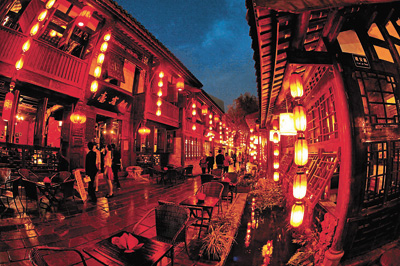
CHENGDU is hardly a fabled destination of the “exotic Orient” — even though this fog-bound river town of 10 million is the only city in China to be known by the same name for more than two millennia. Recently, National Geographic Traveler magazine announced its annual Best of the World list in its December/January 2017 issue, which highlights 21 must-see places to visit in 2017, including Chengdu. The destinations were all chosen by its editors and fall into one of three categories — Cities, Nature, or Culture. In Chengdu, the thatched cottage of acclaimed Tang Dynasty (618-907) poet Du Fu exudes tranquility, while the Wide and Narrow Lanes brim with restaurants, bars, and shops selling handicrafts. Chengdu’s other leading claim to fame is as the gateway to panda country — a panda breeding and research center that is also home to the rare red panda. If you’ve been to a Sichuan restaurant anywhere on Earth, you can attest to the region’s legendary culinary specialties: kung pao chicken, twice-cooked pork, tea-smoked duck, ma po tofu, hotpot, and more. It’s no wonder that UNESCO designated Chengdu only its second “City of Gastronomy,” citing it as “the cradle and center of Sichuan cuisine.” As the hub of booming western China, more than a two-hour flight from Shenzhen, Chengdu was the capital of the Shu Kingdom during the Three Kingdoms period (220-280), as well as several other local kingdoms in ancient times. Wuhou Shrine Wuhou Shrine (Temple of Marquis Wu) is perhaps the most influential museum of Three Kingdoms relics in China. It was built in the Western Jin period (265-316) in honor of Zhuge Liang, the famous military and political strategist who was prime minister of the Shu Kingdom. The shrine highlights the Zhuge Liang Memorial Temple and the Hall of Liu Bei (founder of the Shu), along with statues of other historical figures, as well as cultural relics like stone inscriptions and tablets. Jinli Nearby Wuhou Shrine, Jinli is a popular commercial and dining area resembling the style of traditional architecture of western Sichuan. It is an old street in Chengdu dating from the Han Dynasty (202 B.C.-A.D. 220). The ancient Jinli was one of the oldest and the most commercialized streets in the history of the Shu and was well-known throughout the country later on. Du Fu Thatched Cottage Du Fu was one of the most noted Tang Dynasty poets. During the An Lushan Rebellion, he left Xi’an (then Chang’an) to take refuge in Chengdu. With the help of his friends, the thatched cottage was built along the Huanhua Stream in the western suburbs of Chengdu, where Du spent four years of his life and produced more than 240 now-famous poems. Jinsha Ruins The Jinsha Ruins were the first significant archaeological discovery in China. The Jinsha Relics Museum is located northwest of Chengdu, about 5 km from downtown. As a theme-park-style museum, it is for the protection, research, and display of Jinsha archaeological relics and findings. Qingyang Taoist Temple Located in the western part of Chengdu, Qingyang Temple (Green Goat Temple) is the largest Daoist temple in Southwest China. The only existing copy of “Daozang Jiyao,” a collection of classic Daoist scriptures, is preserved in the temple. The Wide and Narrow Lanes The Wide and Narrow Lanes were first built during the Qing Dynasty (1644-1911) for soldiers. The lanes remained residential until 2003 when the local government turned the area into a mixed-use strip of restaurants, teahouses, bars and galleries. Historic architecture has been well preserved in the Wide and Narrow Lanes. Chengdu Research Base of Giant Panda Breeding Chengdu has established the world-renowned breeding and research base for giant pandas. Covering tens of hectares with bamboo groves and a native-like habitat, Chengdu Research Base of Giant Panda Breeding is the only one of its kind located in an urban area. In order to better protect wild giant pandas, Chengdu has established nature reserves in other counties. Wenshu Monastery Wenshu Monastery is the best preserved Buddhist temple in Chengdu. It has a history dating back 1,300 years. Parts of Xuanzang’s skull are held in consecration here as a relic. (SD News) | 
